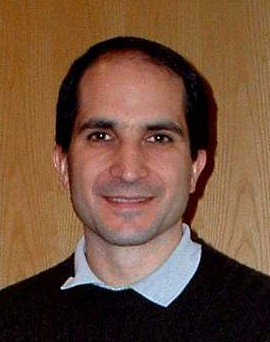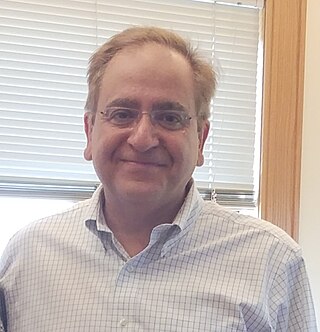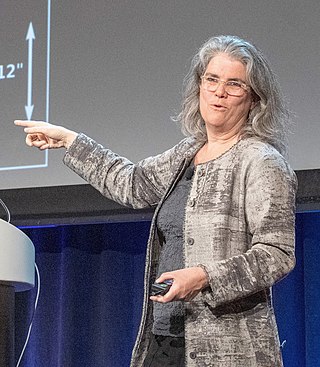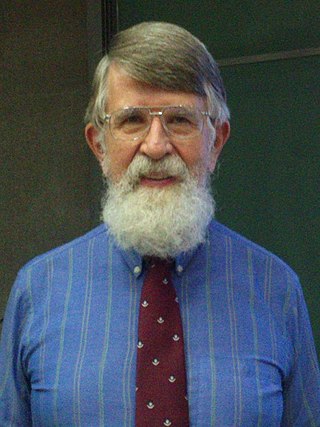Related Research Articles

Juan Martín Maldacena is an Argentine theoretical physicist and the Carl P. Feinberg Professor in the School of Natural Sciences at the Institute for Advanced Study, Princeton. He has made significant contributions to the foundations of string theory and quantum gravity. His most famous discovery is the AdS/CFT correspondence, a realization of the holographic principle in string theory.

Cumrun Vafa is an Iranian-American theoretical physicist and the Hollis Professor of Mathematics and Natural Philosophy at Harvard University.

Erik Peter Verlinde is a Dutch theoretical physicist and string theorist. He is the identical twin brother of physicist Herman Verlinde. The Verlinde formula, which is important in conformal field theory and topological field theory, is named after him. His research deals with string theory, gravity, black holes and cosmology. Currently, he works at the Institute for Theoretical Physics at the University of Amsterdam.

Andrea Mia Ghez is an American astrophysicist, Nobel laureate, and professor in the Department of Physics and Astronomy and the Lauren B. Leichtman & Arthur E. Levine chair in Astrophysics, at the University of California, Los Angeles. Her research focuses on the center of the Milky Way galaxy.

The black hole information paradox is a paradox that appears when the predictions of quantum mechanics and general relativity are combined. The theory of general relativity predicts the existence of black holes that are regions of spacetime from which nothing—not even light—can escape. In the 1970s, Stephen Hawking applied the semiclassical approach of quantum field theory in curved spacetime to such systems and found that an isolated black hole would emit a form of radiation. He also argued that the detailed form of the radiation would be independent of the initial state of the black hole, and depend only on its mass, electric charge and angular momentum.

A physical paradox is an apparent contradiction in physical descriptions of the universe. While many physical paradoxes have accepted resolutions, others defy resolution and may indicate flaws in theory. In physics as in all of science, contradictions and paradoxes are generally assumed to be artifacts of error and incompleteness because reality is assumed to be completely consistent, although this is itself a philosophical assumption. When, as in fields such as quantum physics and relativity theory, existing assumptions about reality have been shown to break down, this has usually been dealt with by changing our understanding of reality to a new one which remains self-consistent in the presence of the new evidence.
The MIT Center for Theoretical Physics (CTP) is the hub of theoretical nuclear physics, particle physics, and quantum information research at MIT. It is a subdivision of MIT Laboratory for Nuclear Science and Department of Physics.

Robert M. Wald is an American theoretical physicist and professor at the University of Chicago. He studies general relativity, black holes, and quantum gravity and has written textbooks on these subjects.

Don Nelson Page is an American-born Canadian theoretical physicist at the University of Alberta, Canada.
John Lawrence CardyFRS is a British–American theoretical physicist. He is best known for his work in theoretical condensed matter physics and statistical mechanics, and in particular for research on critical phenomena and two-dimensional conformal field theory.
Raphael Bousso is a theoretical physicist and cosmologist. He is a professor at the Berkeley Center for Theoretical Physics in the Department of Physics, UC Berkeley. He is known for the Bousso bound on the information content of the universe. With Joseph Polchinski, Bousso proposed the string theory landscape as a solution to the cosmological constant problem.
A black hole firewall is a hypothetical phenomenon where an observer falling into a black hole encounters high-energy quanta at the event horizon. The "firewall" phenomenon was proposed in 2012 by physicists Ahmed Almheiri, Donald Marolf, Joseph Polchinski, and James Sully as a possible solution to an apparent inconsistency in black hole complementarity. The proposal is sometimes referred to as the AMPS firewall, an acronym for the names of the authors of the 2012 paper. The potential inconsistency pointed out by AMPS had been pointed out earlier by Samir Mathur who used the argument in favour of the fuzzball proposal. The use of a firewall to resolve this inconsistency remains controversial, with physicists divided as to the solution to the paradox.
Leon Pape was a medical physicist who received his BSc, MSc (1953) and PhD (1965) in Physics from the University of Southern California. He became certified in radiological physics by the American Board of Radiology and from 1955 to 1962 he worked as a radiological physicist at the Cedars of Lebanon Hospital in Los Angeles. He served at the California State University Los Angeles as radiation safety officer and as professor of physics until 1971, and worked on the development of studies in biophysics, radiological health physics, and electron microscopy. He was elevated to departmental head of physics at Cal State Los Angeles, and advocated with the California legislature to secure adequate funding for the 4-MeV Van de Graaf Laboratory, unique to CSU system. From 1971 until his death he worked at the August Krogh Institute at the University of Copenhagen, Denmark, in the zoophysiological laboratory. His central research area was membrane biophysics.

Samir Dayal Mathur is a theoretical physicist who specializes in string theory and black hole physics.
Ruth Speel Van de Water is an assistant physicist at the U.S. Department of Energy’s Brookhaven National Laboratory. She was also named a finalist in the postdoctoral category of the New York Academy of Sciences’ Blavatnik Awards for Young Scientists in 2011. Van de Water was one of six postdoctoral fellows and seven university faculty members chosen as finalists out of 150 applications for that year. Of those, four were chosen as winners.

Celeste M. Nelson is a Professor of Chemical and Biological Engineering and the Director of the Program in Engineering Biology at Princeton University. She is a Fellow of the American Institute for Medical and Biological Engineering (AIMBE) and was a finalist in the 2017 and 2018 Blavatnik Awards for Young Scientists.
Douglas Stanford is an American theoretical physicist. He is an associate professor of physics at Stanford Institute for Theoretical Physics of Stanford University. His research interests include quantum gravity, quantum field theory and string theory. Stanford was awarded the 2018 New Horizons in Physics Prize by Fundamental Physics Prize Foundation for his work on improving the understanding of quantum mechanics of black holes via chaos theory.
Lisbeth Dagmar Gronlund is an American physicist and nuclear disarmament expert, the former co-director of the Global Security Program for the Union of Concerned Scientists.
Clifford P. Brangwynne is a professor of chemical and biological engineering at Princeton University, the director of the Princeton Bioengineering Initiative, and the June K. Wu ’92 Professor in Engineering. He is also a researcher at the Howard Hughes Medical Institute.
Ahmed Almheiri is an Emirati theoretical physicist. He is currently an assistant professor of physics at New York University Abu Dhabi, Saadiyat Island. He is known for his works on the AdS/CFT correspondence, black hole information paradox and black hole firewalls.
References
- ↑ Musser, George (October 29, 2020), "The Most Famous Paradox in Physics Nears Its End", Quanta Magazine
- 1 2 3 4 "Netta Engelhardt", Physics faculty, Massachusetts Institute of Technology, retrieved 2024-09-21
- 1 2 Engelhardt, Netta (2016), Emergent Geometry from Entropy and Causality (Ph.D. dissertation), University of California, Santa Barbara, Bibcode:2016PhDT........31E, ProQuest 1846186049 , retrieved 2020-11-09
- ↑ "Netta Engelhardt, 2019 Regional Award Winner – Post-Doc", Blavatnik Awards for Young Scientists, retrieved 2020-11-09
- ↑ "Netta Engelhardt", Fundamental Physics Breakthrough Prize Laureates, retrieved 2020-11-09